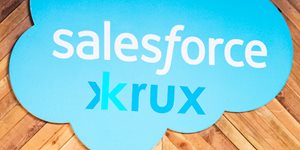Best Practices to Help Your Business Get Acquired
Ernst & Young, the professional services firm, just revealed the results of a new survey they conducted with top executives, called the Global Capital Confidence Barometer. 75% of the respondents stated their company was likely to do some kind of deal over the next year. That was the highest percentage Ernst & Young has ever seen on the regular survey. Moreover, 79% of the executives surveyed said that they had a positive outlook for earnings globally.
 While generally, executives were eyeing smaller deals, more companies appear to be interested in making acquisitions. The M&A barometer has averaged 45% since EY began doing the survey 8 years ago, though it is nearly unchanged from 74% a year ago.
While generally, executives were eyeing smaller deals, more companies appear to be interested in making acquisitions. The M&A barometer has averaged 45% since EY began doing the survey 8 years ago, though it is nearly unchanged from 74% a year ago.
So what is the drive behind this change? Well, the short answer is the pace of innovation. M&A is a unique opportunity for both startups and larger companies in different ways. For the big fish, it means not only do they get a tool to jump into a new market or rapidly ramp up a new technology, but also a quicker solution for time-to-market and talent issues than running internal processes. For the small fish, it is a quick exit strategy, an opportunity to make more cash or a way of speeding up the achievement of their innovation goals by taking advantage of a huge sales and marketing infrastructure or a global distribution channel already set up by larger, more established companies.
Although it sounds like a great win-win situation, this is not a jackpot startups can just wait to stumble upon one day. As Jim Moore, Founder and CEO of J Moore Partners, a firm that specializes in tech M&A, said “with the exception of about half a dozen companies, every tech startup is for sale.” However, it doesn’t mean that every startup can pull off that idyllic sale. It requires a comprehensive strategy, as major tech players have developed an acquisition mindset with entire divisions focused on discovering and procuring the next great startup.
According to Abhey Lamba, an Analyst at Mizuho Securities USA Inc: “The industry is ripe for deals as big companies, bolstered by strong balance sheets, search for growth -- and smaller companies look for new paths to expansion.”
So far this year, I have covered the most recent acquistions news happening in the industry but this time, I would like to share some tactics, alongside best practices to help you navigate these daunting waters:
Establish an Outsized Presence
Just because you have the best technology doesn’t mean potential acquirers will discover you right away. If you believe that you have the most expertise of anyone in your specific business or market, that is great! Do not hold it back, broadcast it to the world. Strategic and effective marketing will bring it to the attention of companies that could potentially acquire your startup. I’m not talking about traditional marketing here though. You should be authentic, and strategic, rather than just shooting off random information. It is not necessary to be featured in major technology news outlets but being a speaker on industry panels, curating a thorough company blog, or being covered by important industry niche publications can go a long way. These avenues not only get your company name out there, but they bring persona to your brand as well as show the unique knowledge and inherent value offered by your startup.
Best Practices: Zite, the developer of a popular news reader app for Apple’s iPad, had a unique technology that gives readers personalized web content presented with a magazine feel. But, the company didn’t only rely on its innovation of personalized article-picking algorithm. They also executed effective marketing tactics that included a very colorful launch which was covered by major US news outlets and newspapers like The Wall Street Journal. Meanwhile, readers had shifted more toward using mobile devices to consume content, so the big media companies were trying to buy the technology to serve up their fare to their audience. As a result, all the marketing efforts made by Zite brought the product to the attention of CNN, and the news giant acquired it just six months after the company launched for $20 million. On a side note, three years after CNN acquired Zite, Flipboard bought it from CNN for around $60 million. "By bringing the Zite team and technology to Flipboard, we can deliver an even more personalized experience to every Flipboard reader," Flipboard CEO Mike McCue said.
that gives readers personalized web content presented with a magazine feel. But, the company didn’t only rely on its innovation of personalized article-picking algorithm. They also executed effective marketing tactics that included a very colorful launch which was covered by major US news outlets and newspapers like The Wall Street Journal. Meanwhile, readers had shifted more toward using mobile devices to consume content, so the big media companies were trying to buy the technology to serve up their fare to their audience. As a result, all the marketing efforts made by Zite brought the product to the attention of CNN, and the news giant acquired it just six months after the company launched for $20 million. On a side note, three years after CNN acquired Zite, Flipboard bought it from CNN for around $60 million. "By bringing the Zite team and technology to Flipboard, we can deliver an even more personalized experience to every Flipboard reader," Flipboard CEO Mike McCue said.
Be Disruptive
Clayton Christensen, Professor at Harvard Business School, was the first to explain the theory of disruptive innovation. He described it in his book The Innovator’s Dilemma as to create new markets by discovering new categories of customers. And the dilemma he shed light on in his book was deciding between retaining a profitable, existing market and investing in rising, new markets. That is actually, the most critical decision that large companies should make, otherwise it is possible to end up like Kodak who went to bankruptcy as it missed the opportunity of digital cameras. Kodak is not the only one either. Nokia, Motorola, and Sony Ericsson have lost a huge market share to Apple since it launched the iPhone.
The reason behind these incidents is because, due to their bureaucracy, big companies are slow to react and not that flexible to chase down every single trend. Therefore, startups are like pawns, as they pave the way when it comes to experimenting new innovations. When they can prove the technology has an attractive return, acquirers will take notice because customers are the measure of the value and potential for your startup in an acquirers' eyes.
Best Practices: Elastica had built a reputation for itself as a major innovator of excellent cloud security solutions. As a result, Blue Coat, which was the market leader in the same field, acquired Elastica for $280 million in order to retain its position as a leader. On an interesting note, only eight months after that, Blue Coat Systems itself was acquired by Bain Capital for $2.4 billion.
Complementary Product
If you don’t have a unique product, it doesn’t mean you can’t lure in acquirers. In fact, acquirers’ most want to hear what gap you will fill or how your product will improve upon theirs in ways they might not have realized. In other words, they have an established presence in their industry but they likely have some holes, so they are interested to hear how you can help them fill those gaps so they can shift their attention back to innovating something else. Sometimes the solution to this kind of problem could be simply building complementary products rather than entirely new ones.
Best Practices: In 2004, Google acquired these three mapping startups, Keyhole, Where2, and Zipdash, in  order to enhance Google Maps. Today, that product has more than 1 billion users and generates revenue through the sale of location-based ads, while being part of the groundwork for Google’s self-driving cars operation. In addition is also adds to the ubiquity of Google’s services, and it furthers Google’s mission of making the world’s information widely accessible.
order to enhance Google Maps. Today, that product has more than 1 billion users and generates revenue through the sale of location-based ads, while being part of the groundwork for Google’s self-driving cars operation. In addition is also adds to the ubiquity of Google’s services, and it furthers Google’s mission of making the world’s information widely accessible.
Build a Superior Team
Apparently, a talented team is the single most important thing that is likely to make you successful. But aside from success, there is another significant opportunity that a great team can bring to table. "Acqui-hiring" startups is a rising trend, especially among tech companies due to the shortage of talent out there. According to John Sullivan, a Professor at San Francisco State University: "The normal recruiting marketplace is fighting over the most skilled workers, so there is no other easy channel left to recruit talent."
Given that one of main reasons large companies acquire startups is for their talent, a great team is also an asset with a specific price tag in the M&A market. Therefore, it is important for startups to invest in talented employees as they’re respected in their industries and have connections to potential acquirers. Google, Facebook, Apple, and others have been silently acqui-hiring startups in recent years. Tim Cook, CEO of Apple, has even publicly stated that this has been Apple’s strategy, “to bring in companies that not only contribute a product but a superior team to add value."
Best Practices: Salesforce CEO Marc Benioff, like other leaders, including Alphabet Executive Chairman Eric Schmidt and Microsoft CEO Satya Nadella, believes so strongly that machine learning is the next big thing in the tech world. But as with many other tech companies, he needed talent in order to develop this major new machine-learning product. The challenge for the industry is that there are simply not enough people with the big-data/machine-learning background to meet this need. So he quietly assembled a team of 175 data scientists, mostly through acquisitions which the company spent almost $5 billion on this year alone. Benioff explained during the quarterly conference call: "Salesforce Einstein is AI for everyone. It's going to democratize artificial intelligence. It's going to make every company and every employee smarter, faster and more productive. We are going to deliver the world's smartest CRM. And as you know, over the last few years we have acquired a number of AI companies — incredible companies like RelateIQ, MetaMind, Implisit, PredictionIO, Tempo AI, and more with amazing, amazing people and technology. We have been able to stitch all this together into this incredible AI platform, and this focus on AI and on the critical aspects of AI as the next wave of our industry has resulted in a machine-learning team of more than 175 data scientists who have built this amazing Einstein platform,"
Schmidt and Microsoft CEO Satya Nadella, believes so strongly that machine learning is the next big thing in the tech world. But as with many other tech companies, he needed talent in order to develop this major new machine-learning product. The challenge for the industry is that there are simply not enough people with the big-data/machine-learning background to meet this need. So he quietly assembled a team of 175 data scientists, mostly through acquisitions which the company spent almost $5 billion on this year alone. Benioff explained during the quarterly conference call: "Salesforce Einstein is AI for everyone. It's going to democratize artificial intelligence. It's going to make every company and every employee smarter, faster and more productive. We are going to deliver the world's smartest CRM. And as you know, over the last few years we have acquired a number of AI companies — incredible companies like RelateIQ, MetaMind, Implisit, PredictionIO, Tempo AI, and more with amazing, amazing people and technology. We have been able to stitch all this together into this incredible AI platform, and this focus on AI and on the critical aspects of AI as the next wave of our industry has resulted in a machine-learning team of more than 175 data scientists who have built this amazing Einstein platform,"
Strengthen Your Hand
Typically, acquirers have far more leverage on many terms of the startup acquisition. The best way to break this is to create a competition. A relatively easier and yet definitely dirtier way is to target the customers of your prospect acquirer. When you poach, say, a $10 million account of a larger rival, they will automatically notice and come try to talk to you about your company, which is precisely what you want as a startup CEO. Another way to create cut-throat competition is to steal the customers from the biggest rival of your prospect acquirer.
Best Practices: Oracle was desperate to steal business from its top competitor Salesforce, so it acquired leading Configure Price Quote (CPQ) provider BigMachines, whose clients were primarily Salesforce users, for $500 million which is five times the value of its revenues.
Partnership
Creating a strategic partnership with your potential acquirers that can develop into a bigger acquisition is the best way to manage this journey, for many reasons. When you look at the history of many overpaid acquisitions, you will see that almost 50% of acquisitions happened as the companies had previously engaged with some level of partnership agreements.
As a startup, it is easier to reach out to the larger companies in an effort to engage in partnership discussions, rather than initiating M&A discussions so you won't be looking desperate to sell your company in the first place. It is just like being engaging prior to marriage, it gives both sides an opportunity to get to know each other and to see if you share similar vision and values.
On the other hand, this is an area that so many organizations fail simply because they are either too timid in cultivating and building relationship with prospect acquirers, or too tactical while initiating interactions, although initiating conversations with no structure isn't good either. Another point missed by many is understanding of how many relationships they’re looking for with which kinds of partners possessing what specific attributes.
Best Practices: Salesforce didn’t have a solution in place to meet its customer's need for data management platform capabilities. In 2015, Salesforce entered into a partnership with five data partners of which Krux was one. However, these partner integrations were not 100% effectively working for their customers as the absorbed data from those partners could not fully support all complex instances for marketer data management. Therefore, as CMS-Connected reported, the CRM software giant snapped up data management platform Krux in an effort to enable its customers to process more data in their CRM systems. The acquisition's price tag was $700 million including both stock and cash.
platform capabilities. In 2015, Salesforce entered into a partnership with five data partners of which Krux was one. However, these partner integrations were not 100% effectively working for their customers as the absorbed data from those partners could not fully support all complex instances for marketer data management. Therefore, as CMS-Connected reported, the CRM software giant snapped up data management platform Krux in an effort to enable its customers to process more data in their CRM systems. The acquisition's price tag was $700 million including both stock and cash.
Have a Glance at Big Tech Acquirers’ Strategies
Google
Many of Google’s most well-known products, including Android, YouTube, Maps, Docs and Analytics, have been designed from acquisitions. When it comes to its acquisition strategy, Google goes after three things:
-
People
-
Businesses directly related to Google's core search business
-
Strategic investments in the future of technology
"First and foremost, their acquisition strategy has always been about talent," said Jon Sakoda, a Partner at New Enterprise Associates. "If you look at the vast majority of the acquisitions that they make—they are acquiring great people and frequently are acquiring people with domain expertise."
According to a Time article, before any deal is finalized, it has to pass what CEO Larry Page calls “the toothbrush test”: is the product something you use daily and would it make your life better? “If anything matches the toothbrush test and relates to technology, then Larry has an interest in it,” said Don Harrison, Google’s Vice President for Corporate Development.
Companies in the advertising, analytics, and internet backbone spaces are potentially on Google’s radar as they are directly related to Google's core business. DoubleClick is a prime example of this, as it marked the company's third largest acquisition to date with $3.1 billion. Google is basically interested in technologies that can get more people on the internet, or more data about people and the world they inhabit.
Google is also captivated by startups once they validate market demand for their products. For instance,  Google already had a video sharing service called Google Video, however, YouTube’s fast-growing user base convinced the firm to offer a whopping price of $1.65 billion for the startup, despite the fact that the company was barely a year old and earned no revenue. Today, YouTube brings in billions of dollars of revenue per year and is the third most-visited website in the world, according to Web analytics firm Alexa.
Google already had a video sharing service called Google Video, however, YouTube’s fast-growing user base convinced the firm to offer a whopping price of $1.65 billion for the startup, despite the fact that the company was barely a year old and earned no revenue. Today, YouTube brings in billions of dollars of revenue per year and is the third most-visited website in the world, according to Web analytics firm Alexa.
Todd Antonelli, a Managing Director at Berkeley Research Group, also pointed out an interesting observation about Google's geographic focus: "They stay really close to their roots — over 60% of their acquisitions are California-based."
Facebook
Facebook’s acquisition strategy is driven by the fear of being bypassed by an up-and-comer social network. The company gets quite aggressive if they realize a drop in their demographic, the mindshare, and the engagement that they are used to having. Let me explain this with a few of examples.
 Facebook's user-base has started aging and lost ground among teens. Meanwhile, Snapchat and Instagram became a new trend in that particular demographic. In fact, according to Piper Jaffray's most recent semi-annual "Taking Stock with Teens" survey, teenagers' most preferred social networking medium was Snapchat, followed by Instagram, while Twitter and Facebook were at the third and fourth spots, respectively in the survey. Fortunately, Facebook diagnosed that before it was too late and attempted to acquire Snapchat for $3 billion, as that acquisition would have been a great opportunity to expand its existing user base. In the end, this acquisition has never materialized for some other reasons but it still demonstrates the company's acquisition mindset and approach.
Facebook's user-base has started aging and lost ground among teens. Meanwhile, Snapchat and Instagram became a new trend in that particular demographic. In fact, according to Piper Jaffray's most recent semi-annual "Taking Stock with Teens" survey, teenagers' most preferred social networking medium was Snapchat, followed by Instagram, while Twitter and Facebook were at the third and fourth spots, respectively in the survey. Fortunately, Facebook diagnosed that before it was too late and attempted to acquire Snapchat for $3 billion, as that acquisition would have been a great opportunity to expand its existing user base. In the end, this acquisition has never materialized for some other reasons but it still demonstrates the company's acquisition mindset and approach.
On the other hand, the company successfully bought the top mobile photo-sharing application among photographers and photo lovers, Instagram, for approximately $1 billion in cash and stock as Instagram was huge as a threat to Facebook’s dominance in photo sharing.
WhatsApp was another important acquisition that helped Facebook gain a stronger international audience they couldn't capture with their Messenger service, although the deal cost Facebook almost $22 billion with the additional rise in Facebook's stock value.
Oracle
The drive behind Oracle’s M&A activities is to support the full transition to Saas/cloud-based solutions and diversification into new high growth markets. One of the primary criteria considered when Oracle is looking to buy an organization is if the company posses healthy maintenance revenue streams. If you are a B2B-focused cloud company, you should consider Oracle as a potential acquirer as long as you can offer a compelling reason for the capital they spend to be owners of your company.
As CMS-Connected reported, Oracle agreed to acquire cloud-based ERP provider NetSuite for about $9.3  billion in cash, aiming to gain market share in the fast-growing cloud computing business, where the company has been lagging the competition. The acquisition is considered to be the least shocking acquisition news in the history of enterprise software due to the long history between Oracle and NetSuite. "It’s like the high school sweethearts you always knew would get married but they had to get through four years of college first," said Frank Scavo, President of Strativa. Jokes aside, it shows the importance of building the relationships that were discussed above.
billion in cash, aiming to gain market share in the fast-growing cloud computing business, where the company has been lagging the competition. The acquisition is considered to be the least shocking acquisition news in the history of enterprise software due to the long history between Oracle and NetSuite. "It’s like the high school sweethearts you always knew would get married but they had to get through four years of college first," said Frank Scavo, President of Strativa. Jokes aside, it shows the importance of building the relationships that were discussed above.
Oracle has also paid special attention to companies in applications, middleware, industry solutions, and infrastructure.
Before You Go
One way to faster growth and recognition is to sell your company to a larger competitor or related corporation but the most important step is to reflect on what you expect to attain from the deal and how you want it to be managed. If you don’t already have a prospective buyer, spend considerable time developing what the ideal acquirer’s profile would be and what corporate culture and values would be an organic fit. The acquisition process is already long and complex so make sure all taxes are filed, finances are in order and there are no outstanding issues that could arise and slow progress. It is a good idea to invite an experienced, unbiased professional to review your business "through the buyer's eyes". An experienced M&A advisor can review your business and provide a list of perceived strengths and weaknesses that may have a significant impact on the amount a buyer will pay for your business. Finally, don't underestimate the power of a compelling, credible story to tell post acquisition to convince employees, customers, and stakeholders to accompany you as you embark on your new journey.

Venus Tamturk
Venus is the Media Reporter for CMS-Connected, with one of her tasks to write thorough articles by creating the most up-to-date and engaging content using B2B digital marketing. She enjoys increasing brand equity and conversion through the strategic use of social media channels and integrated media marketing plans.